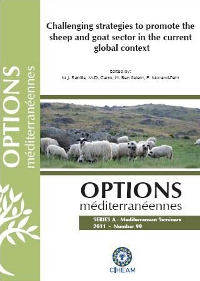| Article précédent | p. 195-199 | Article suivant |
Difference in trace mineral status among genetic groups of goats
University Goat & Sheep Farm, Mannuthy, Kerala, India, formed the venue for study. It houses purebred native breeds like Malabari & Attappady Black, along with Malabari crossbreds (Malabari with Saanen, Alpine and Boer). Major problems which the farm faced were increased kid mortality rate and ill thrift among adult animals, with lusterless hair coat and low productivity. Trace elements play an important role in many essential metabolic functions and trace mineral deficiency affects many vital systems in the body. At the beginning of the study, Malabari, Attappady Black and crossbred goats were tested for serum copper levels and their means with standard error were 53.80 ± 4.84, 44.00 ± 2.12 and 51.14 ± 3.67 µg/dl, respectively indicating marginal copper deficiency. Differences exist between individuals and between breeds regarding trace mineral status and their threshold levels in the serum. So the study was conducted with the objective of finding out the effect of genetic groups on the levels of trace minerals in the serum of goats of Kerala. After a ten month period of mineral supplementation with calcium, manganese, iodine, iron, zinc, copper and cobalt, at the rate of 0.6 percent, there was definite improvement in the productive and reproductive status of adult animals. Mineral estimation was done systematically among three different genetic groups, and it revealed that overall mean values of copper, iron, selenium and cobalt were 88.72 ± 6.83 µg/dl, 1.53 ± 0.18ppm, 25.02 ± 0.83 µg/dl and 1.33 ± 0.01ppm, respectively. Serum copper levels showed improvement with a mean value of 81.00 ± 4.75, 63.13 ± 7.75 and 117.70 ± 14.01 µg/dl in Malabari, Attappady Black and crossbreds, respectively. Statistically significant difference existed between genetic groups in the case of serum copper and selenium levels (P<0.05) indicating that tolerant breeds can be utilized for crossing with more susceptible ones to decrease the incidence of deficiencies and lessen the dependence on supplementation where problems are endemic.
Cette étude a eu lieu dans le cadre de la ferme ovine et caprine de l'Université, à Mannuthy, Kerala, en Inde. Elle abrite des races pures autochtones telles que Malabari et Attappady Black, de même que des croisements avec Malabari (Malabari avec Saanen, Alpine et Boer). Les problèmes majeurs que la ferme rencontre sont un taux de mortalité accru des chevreaux et une mauvaise santé des animaux adultes, qui ont une robe terne et une faible productivité. Les oligo-éléments jouent un rôle important pour de nombreuses fonctions métaboliques essentielles, et leur carence affecte plusieurs systèmes biologiques vitaux. Au début de l'étude, les animaux Malabari, Attappady Black et croisés furent testés pour les niveaux de cuivre sérique et leurs moyennes, avec erreur-type, furent de 53,80 ± 4,84, 44,00 ± 2,12 et 51,14 ± 3,67 µg/dl, indiquant respectivement une carence marginale en cuivre. Des différences furent trouvées entre individus et entre races concernant les concentrations en oligo-éléments et leur niveau de seuil sérique. Ainsi l'étude fut menée dans l'objectif de découvrir l'effet des groupes génétiques sur les niveaux d'oligo-éléments sériques de caprins de Kerala. Après une période de dix mois de supplémentation minérale avec calcium, manganèse, iode, fer, zinc, cuivre et cobalt, selon un taux de 0,6 pour cent, il y eut une nette amélioration de la situation productive et reproductive des animaux adultes. Une estimation minérale fut systématiquement effectuée parmi trois groupes génétiques différents, qui révéla que les valeurs moyennes d'ensemble pour le cuivre, fer, sélénium et cobalt étaient de 88,72 ± 6,83 µg/dl, 1,53 ± 0,18 ppm, 25,02 ± 0,83 µg/dl et 1,33 ± 0,01 ppm, respectivement. Les niveaux de cuivre sérique montraient une amélioration, avec une valeur moyenne de 81,00 ± 4,75, 63,13 ± 7,75 et 117,70 ± 14,01 µg/dl chez les animaux Malabari, Attappady Black et croisés, respectivement. Il existait une différence statistiquement significative entre les groupes génétiques dans le cas des niveaux sériques de cuivre et de sélénium (P<0.05) indiquant que les races tolérantes peuvent être utilisées en croisement avec d'autres plus sensibles pour diminuer l'incidence des carences et réduire la dépendance de la supplémentation là où des problèmes endémiques existent.
- [ Afficher ]
- [ Télécharger ]
- [ Exporter la citation ]
Vous pouvez télécharger la citation au format :
- [ Imprimer ]
-
Mots-clés
CAPRIN, CUIVRE, RACE INDIGENE, OLIGO-ALIMENTCiter cet article
Radhika G., Raghavan K.C., Ajithkumar S., Reghunandanan K.V., Alex R., Thomas N. Difference in trace mineral status among genetic groups of goats. In : Ranilla M.J. (ed.), Carro M.D. (ed.), Ben Salem H. (ed.), Morand-Fehr P. (ed.). Challenging strategies to promote the sheep and goat sector in the current global context. Zaragoza : CIHEAM / CSIC / Universidad de León / FAO, 2011. p. 195-199. (Options Méditerranéennes : Série A. Séminaires Méditerranéens; n. 99). 13. International Seminar of the Sub-Network on Nutrition of the FAO-CIHEAM Inter-Regional Cooperative Research and Development Network on Sheep and Goats, 2009/10/14-16, León (Spain). http://om.ciheam.org/om/pdf/a99/00801556.pdf



